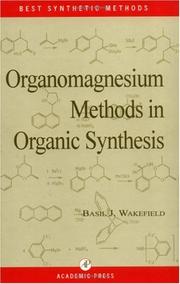| Listing 1 - 3 of 3 |
Sort by
|
Book
ISBN: 1000013975 3866444508 Year: 2010 Publisher: KIT Scientific Publishing
Abstract | Keywords | Export | Availability | Bookmark
 Loading...
Loading...Choose an application
- Reference Manager
- EndNote
- RefWorks (Direct export to RefWorks)
This computational study investigates diverse bonding situations in nanostructures (carbon nanotubes, fullerenes, metal compounds) spanning a broad range of energies. Weak, dispersive interactions and covalent metal-ligand and metal-metal bonding are examined. The results of efficient density functional calculations are compared to those of correlated wavefunction calculations on model systems. This rigorous validation is crucial in evaluating the balance between computational cost and accuracy.

ISBN: 0127309454 9786611033750 1281033758 0080538177 9780127309453 9780080538174 Year: 1995 Publisher: London ; San Diego : Academic Press,
Abstract | Keywords | Export | Availability | Bookmark
 Loading...
Loading...Choose an application
- Reference Manager
- EndNote
- RefWorks (Direct export to RefWorks)
The book opens with a general overview of the constitution and reactivity of organomagnesium compounds, followed by information on handling them and on their detection and estimation. Throughout, practical aspects aswell as principles are emphasized.The chapters on the synthesis of organomagnesium compounds cover the preparation of special forms of metallic magnesium and the reaction of magnesium with substrates such as dienes, as well as the traditional preparation of Grignard reagents. Preparations by metallation and metal-halogen exchanges are also included, as are newer methods such as
Organomagnesium compounds. --- Organic compounds --- Composés organiques --- Synthesis. --- Synthèse --- 547.057 --- 546.46 --- Organic chemistry--?.057 --- Magnesium Mg --- 546.46 Magnesium Mg --- 547.057 Organic chemistry--?.057 --- Composés organiques --- Synthèse --- Grignard reagents. --- Grignard reaction --- Chemical tests and reagents --- Organomagnesium compounds --- Magnesium organic compounds --- Magnesium compounds --- Organometallic compounds --- Grignard reagents --- ORGANIC COMPOUNDS --- MAGNESIUM COMPOUNDS --- ORGANOMETALLIC COMPOUNDS --- PREPARATION --- REACTIONS
Book
ISBN: 9789812873729 9812873716 9789812873712 9812873724 Year: 2015 Publisher: Singapore : Springer Singapore : Imprint: Springer,
Abstract | Keywords | Export | Availability | Bookmark
 Loading...
Loading...Choose an application
- Reference Manager
- EndNote
- RefWorks (Direct export to RefWorks)
This book critically summarizes the effects of various suitable alloying elements and particulate reinforcements on mechanical and degradation properties of pure Mg and Mg alloys targeting biomedical applications. The suitability of alloying elements and particulate reinforcements are discussed based on their levels of toxic effects on human body. First attempt is made to study and discuss on the various available synthesizing techniques for fabrication of both impermeable and porous Mg materials. Further, more emphasis on development of new magnesium matrix nanocomposites (MMNC) is made owing to the similarities between natural bone and MMNCs as bio-“nanocomposite”. The information on synthesis, toxicity of alloying elements and reinforcements and their effects on mechanical and degradation properties of pure Mg will enable the researchers to effectively design Mg alloys and composites targeting biomedical applications.
Materials Science. --- Biomaterials. --- Materials Engineering. --- Biomedical Engineering. --- Metallic Materials. --- Biomedical engineering. --- Materials. --- Génie biomédical --- Matériaux --- Health & Biological Sciences --- Biomedical Engineering --- Magnesium compounds. --- Magnesium alloys. --- Metallic composites. --- Biomedical materials. --- Biocompatible materials --- Biomaterials --- Medical materials --- Medicine --- Metal composites --- Metal matrix composites --- Materials --- Materials science. --- Engineering --- Metals. --- Composite materials --- Metals --- Light metal alloys --- Biomedical engineering --- Biocompatibility --- Prosthesis --- Alkaline earth compounds --- Biomedical Engineering and Bioengineering. --- Engineering materials --- Industrial materials --- Engineering design --- Manufacturing processes --- Clinical engineering --- Medical engineering --- Bioengineering --- Biophysics --- Engineering—Materials. --- Bioartificial materials --- Hemocompatible materials --- Metallic elements --- Chemical elements --- Ores --- Metallurgy --- Biomaterials (Biomedical materials)
| Listing 1 - 3 of 3 |
Sort by
|

 Search
Search Feedback
Feedback About UniCat
About UniCat  Help
Help News
News